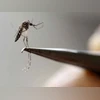India recorded 2,34,427 cases of dengue till November 30 this year, the government told Lok Sabha on Friday and underlined that the cases remain low every year from January to July whereas maximum cases are reported from August to December.
In the current year, due to global climate change, the El Nino effect and unequal rainfall, increased vector density led to an increase in the number of dengue cases reported across the country, Union Minister of State for Health S P Singh Baghel said in reply to a question.
Baghel informed the House that 2,33,251 cases of dengue were reported in 2022 and 1,93,245 in 2021.
Transmission of dengue happens round the year in many states. However, cases increase during monsoon and continue till the post-monsoon season due to the abundance of vector breeding sites, he said.
"For dengue transmission, environmental factors namely rainfall, humidity and temperature are mainly responsible. In the current year, due to the global climate change, El Nino effect and unequal rainfall, increased vector density led to an increase in the number of dengue cases reported across the country in the current year," Baghel said.
Also Read
On the development of a vaccine against dengue, he said it is very challenging mainly due to the existence of four different serotypes with no cross-protection, no well-established animal models to understand the immunopathogenesis of disease, no established correlates of protection and lack of good immunological assays.
"The WHO target product profile for dengue vaccine is not yet available, as informed by the Indian Council of Medical Research (ICMR). The ICMR has recently signed an MoU with Panacea Biotech and Serum Institute of India for clinical trial of a dengue vaccine candidate," the minister stated.
The ICMR has been working on creating awareness through its research institutions in the form of outreach programmes and training and awareness programmes among masses through public lectures, live demonstrations, training and research, he said.
The ICMR is using the latest technologies like remote sensing and geographical information systems for risk mapping of areas and planning interventions, Baghel added.
(Only the headline and picture of this report may have been reworked by the Business Standard staff; the rest of the content is auto-generated from a syndicated feed.)

)
